Understanding the Spatial-Temporal Changes of Oasis Farmland in the Tarim River Basin from the Perspective of Agricultural Water Footprint
Abstract
:1. Introduction
2. Study Area, Data and Methodology
2.1. Study Site Description
2.2. Data Sources
2.2.1. Land Use Data Acquisition and Processing
2.2.2. Meteorological, Water Resources and Statistical Data
2.3. Methodology
2.3.1. Water Footprint of Crop Production
2.3.2. Standard Deviation Ellipse Analysis
2.3.3. Theory of Water Footprint and Farmland Matching
2.3.4. Sensitivity Index (SI)
3. Results
3.1. Crop Production Water Footprint and Farmland Resources
3.2. Spatial Distribution Characteristics of Crop Production Water Footprint and Oasis Farmland
3.3. Spatial Matching Analysis of Crop Production Water Footprint and Oasis Farmland
3.4. Sensitivity Analysis of Crop Production Water Footprint and Oasis Farmland
4. Discussion
4.1. Main Factors Influencing Crop Water Footprint and Farmland Resource Changes
4.2. Implications and Suggestions from Spatial Matching Theory and Sensitivity Analysis
5. Conclusions
Author Contributions
Funding
Acknowledgments
Conflicts of Interest
References
- Xue, X.; Liao, J.; Hsing, Y.; Huang, C.; Liu, F. Policies, land use, and water resource management in an arid oasis ecosystem. Environ. Manag. 2015, 55, 1036–1051. [Google Scholar] [CrossRef]
- Fitton, N.; Alexander, P.; Arnell, N.; Bajzelj, B.; Calvin, K.; Doelman, J.; Gerber, J.S.; Havlik, P.; Hasegawa, T.; Herrero, M.; et al. The vulnerabilities of agricultural land and food production to future water scarcity. Glob. Environ. Chang. 2019, 58, 101944. [Google Scholar] [CrossRef]
- Zhao, X.; Othmanli, H.; Schiller, T.; Zhao, C.; Sheng, Y.; Zia, S.; Muller, J.; Stahr, K. Water use efficiency in saline soils under cotton cultivation in the Tarim River Basin. Water 2015, 7, 3103–3122. [Google Scholar] [CrossRef]
- Huang, S.; Wortmann, M.; Duethmann, D.; Menz, C.; Shi, F.; Zhao, C.; Su, B.; Krysanova, V. Adaptation strategies of agriculture and water management to climate change in the Upper Tarim River basin, NW China. Agric. Water Manag. 2018, 203, 207–224. [Google Scholar] [CrossRef]
- Xue, L.; Wang, J.; Zhang, L.; Wei, G.; Zhu, B. Spatiotemporal analysis of ecological vulnerability and management in the Tarim River Basin, China. Sci. Total Environ. 2019, 649, 876–888. [Google Scholar] [CrossRef]
- Waldron, B.; Gui, D.; Liu, Y.; Feng, L.; Dai, H. Assessing water distribution and agricultural expansion in the Cele Oasis, China. Environ. Monit. Assess. 2020, 192, 1–19. [Google Scholar] [CrossRef] [PubMed] [Green Version]
- Li, H.; Zhou, W.; Zhuang, Y.; Cong, M.; Liu, B. Agricultural water and soil resources matching patterns and carrying capacity in Yan’an City. Trans. Chin. Soc. Agric. Eng. 2016, 32, 156–162. (In Chinese) [Google Scholar]
- Du, J.; Yang, Z.; Wang, H.; Yang, G.; Li, S. Spatial–temporal matching characteristics between agricultural water and land resources in Ningxia, Northwest China. Water 2019, 11, 1460. [Google Scholar] [CrossRef] [Green Version]
- Zhang, Y.; Yan, Z.; Song, J.; Wei, A.; Sun, H.; Cheng, D. Analysis for spatial-temporal matching pattern between water and land resources in Central Asia. Hydrol. Res. 2020, 10, 1–20. [Google Scholar]
- Yang, Q.; Yang, X.L.; Qiao, C.; Zuo, Y.; Cui, Y.; Jin, J. Matching analysis of water and land resources in Anhui Province based on Gini coefficient. Chin. Agric. Sci. Bull. 2016, 32, 72–76. (In Chinese) [Google Scholar]
- Jiang, Q.X.; Fu, Q.; Wang, Z.L.; Jiang, N. Spatial matching patterns of land and water resources in Sanjiang Plain. J. Nat. Resour. 2011, 26, 270–277. (In Chinese) [Google Scholar]
- Zheng, J.; Zhao, X.; Cao, X.; Sun, S.; Zhang, L. Study on spatiotemporal matching pattern of agricultural water and land resources in Hetao irrigation district. Res. Soil Water Conserv. 2015, 22, 132–136. [Google Scholar]
- Sun, S.; Wu, P.; Wang, Y.; Zhao, X.; Liu, J.; Zhang, X. The impacts of interannual climate variability and agricultural inputs on water footprint of crop production in an irrigation district of China. Sci. Total Environ. 2013, 444, 498–507. [Google Scholar] [CrossRef]
- Chapagain, A.K.; Hoekstra, A.Y. The blue, green and grey water footprint of rice from production and consumption perspectives. Ecol. Econ. 2011, 70, 749–758. [Google Scholar] [CrossRef]
- Veettil, A.V.; Mishra, A.K. Water security assessment using blue and green water footprint concepts. J. Hydrol. 2016, 542, 589–602. [Google Scholar] [CrossRef]
- Hoekstra, A.Y.; Mekonnen, M.M. The water footprint of humanity. Proc. Natl. Acad. Sci. USA 2012, 109, 3232–3237. [Google Scholar] [CrossRef] [Green Version]
- Zhang, P.; Deng, X.; Long, A.; Hai, Y.; Li, Y.; Wang, H.; Xu, H. Impact of social factors in agricultural production on the crop water footprint in Xinjiang, China. Water 2018, 10, 1145. [Google Scholar] [CrossRef] [Green Version]
- Xinjiang Uygur Autonomous Region Statistics Bureau. Xinjiang Statistical Yearbook; China Statistics Press: Beijing, China, 2019. (In Chinese) [Google Scholar]
- Ling, H.; Guo, B.; Zhang, G.; Xu, H.; Deng, X. Evaluation of the ecological protective effect of the “large basin” comprehensive management system in the Tarim River basin, China. Sci. Total Environ. 2019, 650, 1696–1706. [Google Scholar] [CrossRef]
- Yu, J.; Long, A.; Deng, X.; He, X.; Zhang, P.; Wang, J.; Hai, Y. Incorporating the red jujube water footprint and economic water productivity into sustainable integrated management policy. J. Environ. Manag. 2020, 269, 110828. [Google Scholar] [CrossRef]
- Hoekstra, A.Y.; Chapagain, A.K.; Aldaya, M.M.; Mekonnen, M.M. The Water Footprint Assessment Manual: Setting the Global Standard; Earthscan: London, UK, 2011. [Google Scholar]
- Liu, H.; Fang, C.; Miao, Y.; Ma, H.; Zhang, Q.; Zhou, Q. Spatio-temporal evolution of population and urbanization in the countries along the Belt and Road 1950–2050. J. Geogr. Sci. 2018, 28, 919–936. [Google Scholar] [CrossRef] [Green Version]
- Yang, Z.; Xiu, Q.; Chen, D. Historical changes in the port and shipping industry in Hong Kong and the underlying policies. Transp. Policy. 2019, 82, 138–147. [Google Scholar] [CrossRef]
- Ma, J.; Chen, H.; Gao, X.; Xiao, J.; Wang, H. African swine fever emerging in China: Distribution characteristics and high-risk areas. Prev. Vet. Med. 2020, 175, 104861. [Google Scholar] [CrossRef] [PubMed]
- Ayana, E.K.; Ceccato, P.; Fisher, J.R.B.; DeFries, R. Examining the relationship between environmental factors and conflict in pastoralist areas of East Africa. Sci. Total Environ. 2016, 557, 601–611. [Google Scholar] [CrossRef]
- Groves-Kirkby, C.J.; Denman, A.R.; Phillips, P.S. Lorenz curve and Gini coefficient: Novel tools for analysing seasonal variation of environmental radon gas. J. Environ. Manag. 2009, 90, 2480–2487. [Google Scholar] [CrossRef]
- Gobillon, L.; Selod, H.; Zenou, Y. The mechanisms of spatial mismatch. Urban Stud. 2007, 44, 2401–2427. [Google Scholar] [CrossRef] [Green Version]
- Naghibi, S.A.; Moghaddam, D.D.; Kalantar, B.; Pradhan, B.; Kisi, O. A comparative assessment of GIS-based data mining models and a novel ensemble model in groundwater well potential mapping. J. Hydrol. 2017, 548, 471–483. [Google Scholar] [CrossRef]
- Han, Z.; Song, W.; Deng, X. Responses of ecosystem service to land use change in Qinghai Province. Energies 2016, 9, 303. [Google Scholar] [CrossRef] [Green Version]
- Gong, B.; Liu, Z. Assessing impacts of land use policies on environmental sustainability of oasis landscapes with scenario analysis: The case of northern China. Landsc. Ecol. 2020, 1–20. [Google Scholar] [CrossRef]
- Zhang, Z.; Xia, F.; Yang, D.; Huo, J.; Wang, G.; Chen, H. Spatiotemporal characteristics in ecosystem service value and its interaction with human activities in Xinjiang, China. Ecol. Indic. 2020, 110, 105826. [Google Scholar] [CrossRef]
- Wang, Y.; Zhang, S.; Zhen, H.; Chang, X.; Shataer, R.; Li, Z. Spatiotemporal evolution characteristics in ecosystem service values based on land use/cover change in the Tarim River Basin, China. Sustainability 2020, 12, 7759. [Google Scholar] [CrossRef]
- Long, A.; Zhang, P.; Hai, Y.; Deng, X.; Li, J.; Wang, J. Spatio-temporal variations of crop water footprint and its influencing factors in Xinjiang, China during 1988–2017. Sustainability 2020, 12, 9678. [Google Scholar] [CrossRef]
- Mekonnen, M.M.; Hoekstra, A.Y. Water footprint benchmarks for crop production: A first global assessment. Ecol. Indic. 2014, 46, 214–223. [Google Scholar] [CrossRef] [Green Version]
- Vanham, D.; Mekonnen, M.M. The scarcity-weighted water footprint provides unreliable water sustainability scoring. Sci. Total Environ. 2021, 756, 143992. [Google Scholar] [CrossRef]
- Vanham, D.; Hoekstra, A.Y.; Wada, Y.; Bouraoui, F.; de Roo, A.; Mekonnen, M.M.; van de Bund, W.J.; Batelaan, O.; Pavelic, P.; Bastiaanssen, W.G.M.; et al. Physical water scarcity metrics for monitoring progress towards SDG target 6.4: An evaluation of indicator 6.4. 2 “Level of water stress”. Sci. Total Environ. 2018, 613, 218–232. [Google Scholar] [CrossRef] [PubMed]
- Mekonnen, M.M.; Hoekstra, A.Y. Four billion people facing severe water scarcity. Sci. Adv. 2016, 2, e1500323. [Google Scholar] [CrossRef] [PubMed] [Green Version]
- Fang, G.; Chen, Y.; Li, Z. Variation in agricultural water demand and its attributions in the arid Tarim River Basin. J. Agric. Sci. 2018, 156, 301–311. [Google Scholar] [CrossRef]
- Yang, Y.; Liu, Y. Spatio-temporal analysis of urbanization and land and water resources efficiency of oasis cities in Tarim River Basin. J. Geogr. Sci. 2014, 24, 509–525. [Google Scholar] [CrossRef]
- Chai, J.; Wang, Z.; Yang, J.; Zhang, L. Analysis for spatial-temporal changes of grain production and farmland resource: Evidence from Hubei Province, central China. J. Clean. Prod. 2019, 207, 474–482. [Google Scholar] [CrossRef]
- Liu, Y.; Chen, Y. Impact of population growth and land-use change on water resources and ecosystems of the arid Tarim River Basin in Western China. Int. J. Sustain. Dev. World Ecol. 2006, 13, 295–305. [Google Scholar] [CrossRef]
- Chinese Ministry of Agriculture; Chinese Ministry of Finance. Guiding Opinions on Adjusting the Three Agricultural Subsidies Policies. Available online: http://nys.mof.gov.cn/zhengfuxinxi/czpjZhengCeFaBu_2_2/201505/t20150522_1237664.html (accessed on 28 December 2020).
- Yildiz, O. Object-based modeling of restrictions on the sale of agricultural land. Land Use Policy 2019, 82, 538–549. [Google Scholar] [CrossRef]
- Zhang, X.; Liu, J.; Zhao, X.; Yang, H.; Deng, X.; Jiang, X.; Li, Y. Linking physical water consumption with virtual water consumption: Methodology, application and implications. J. Clean. Prod. 2019, 228, 1206–1217. [Google Scholar] [CrossRef]
- Gao, D.; Long, A.; Yu, J.; Xu, H.; Su, S.; Zhao, X. Assessment of inter-sectoral virtual water reallocation and linkages in the Northern Tianshan Mountains, China. Water 2020, 12, 2363. [Google Scholar] [CrossRef]
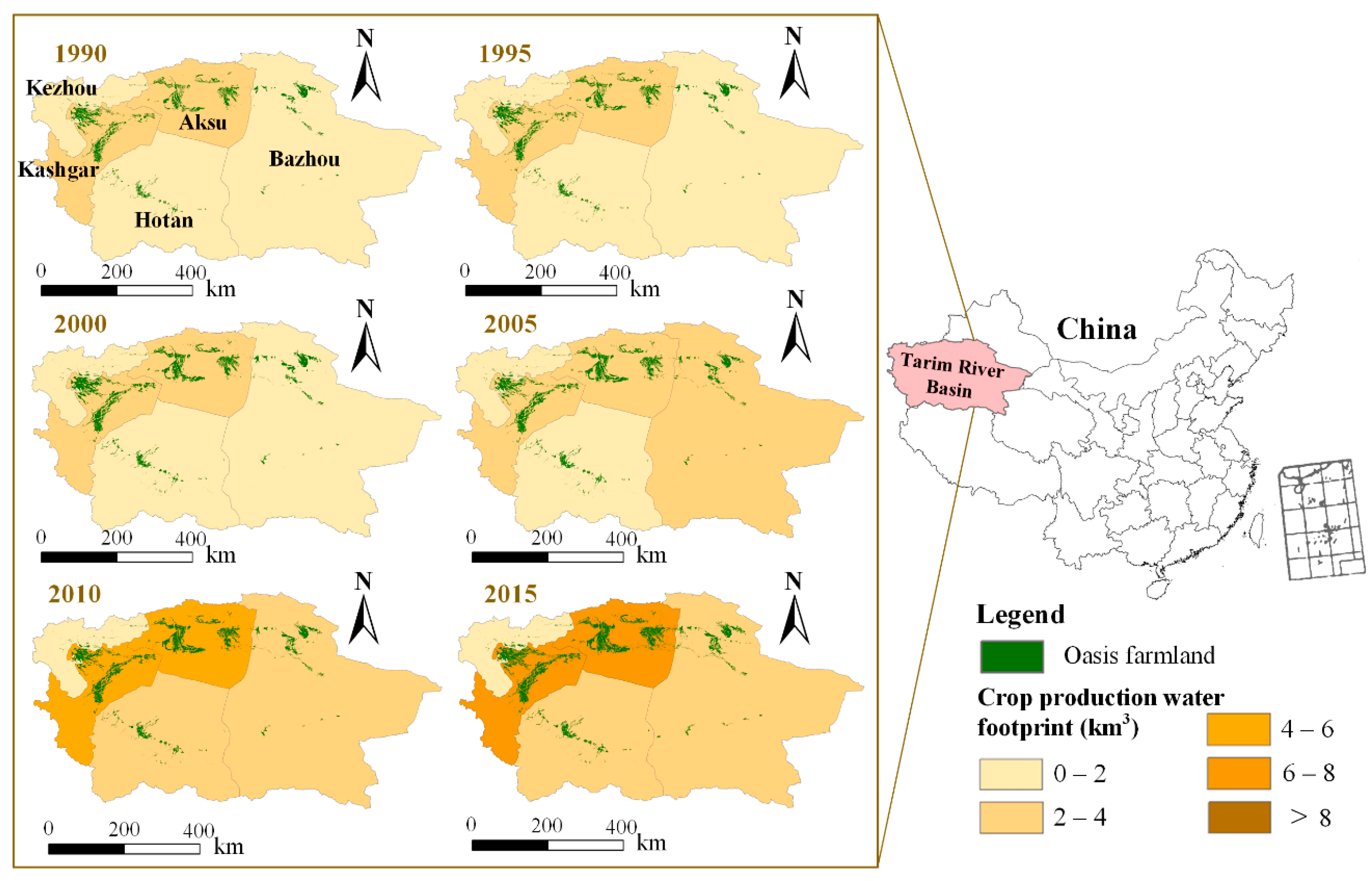
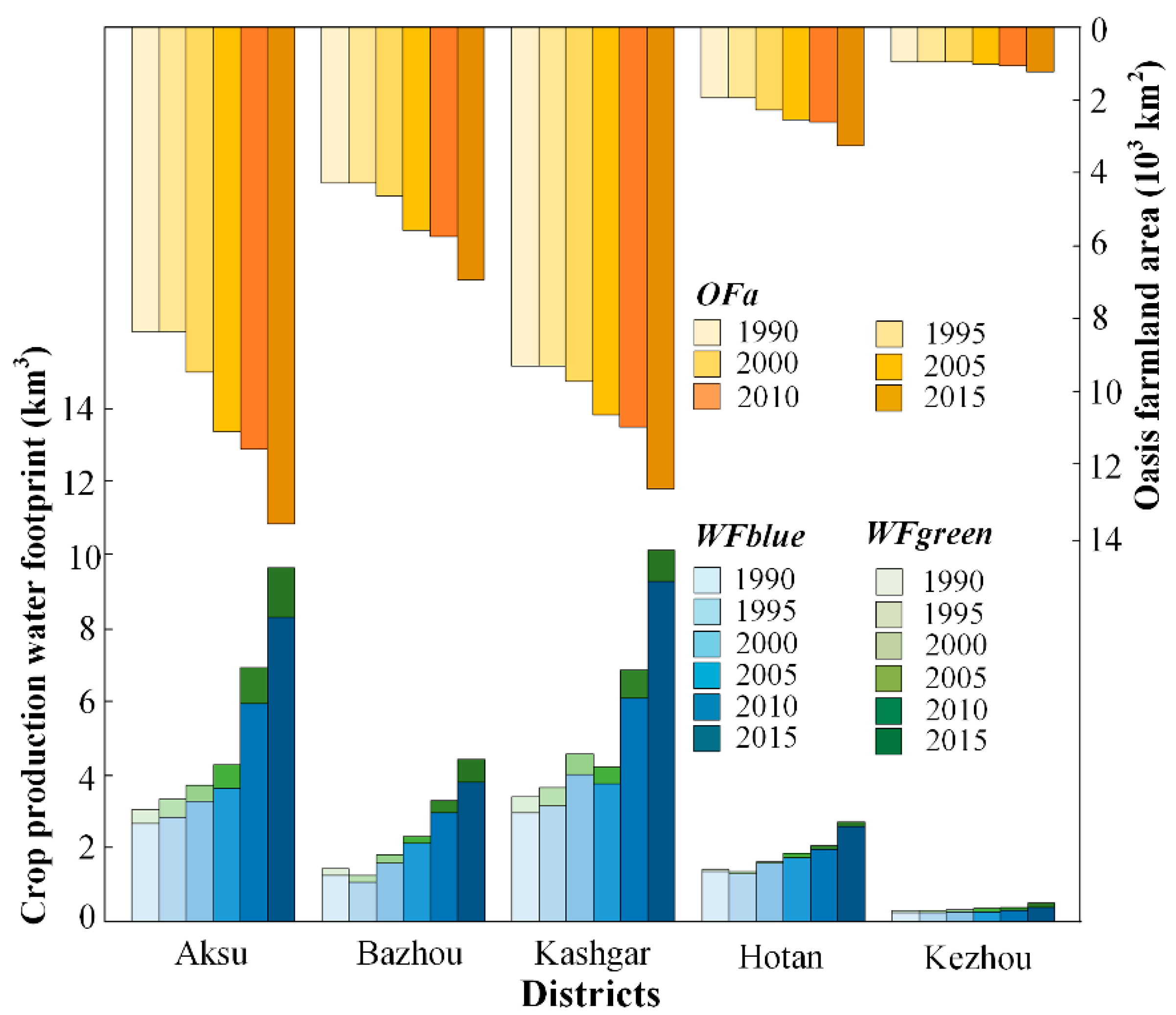
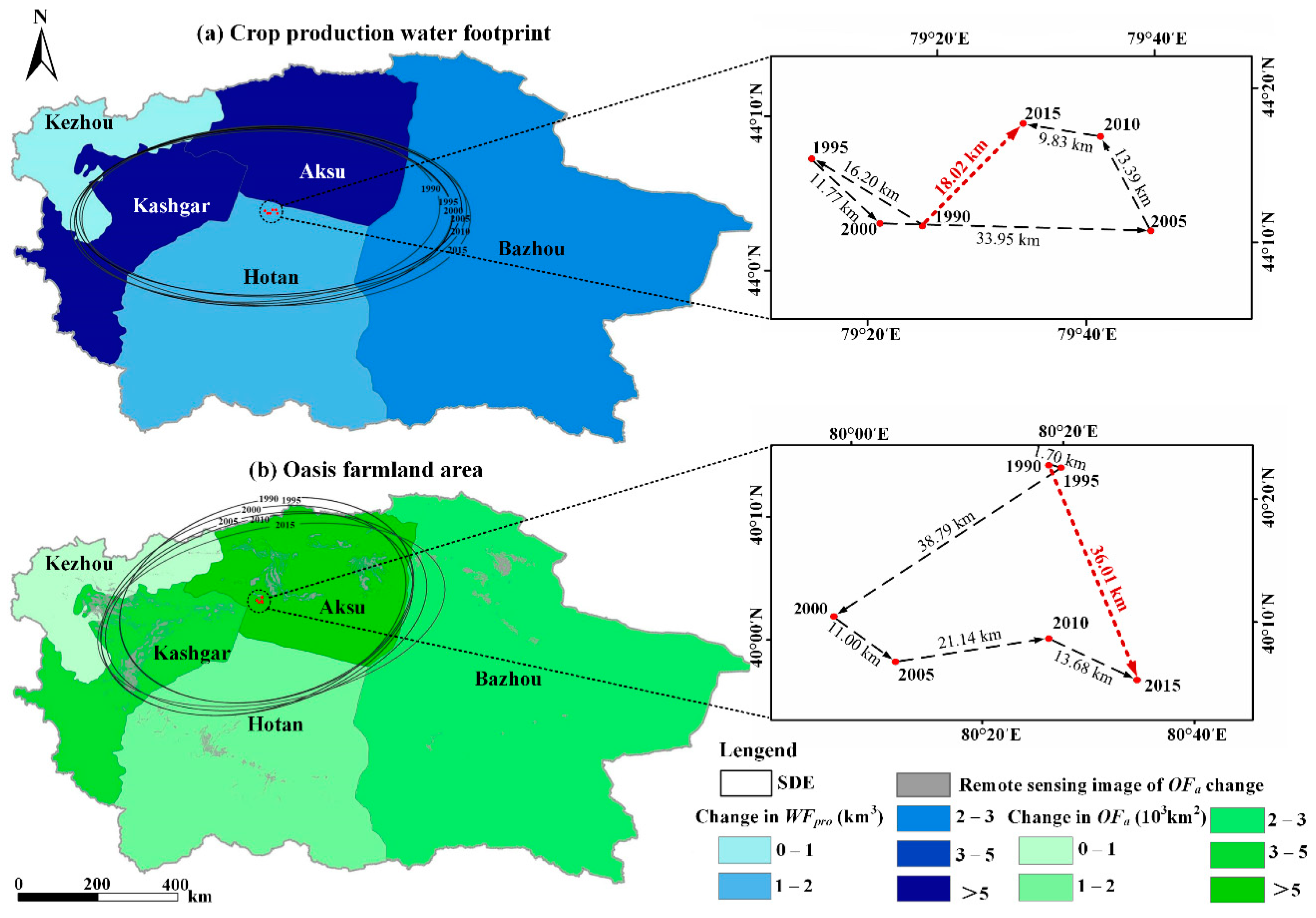
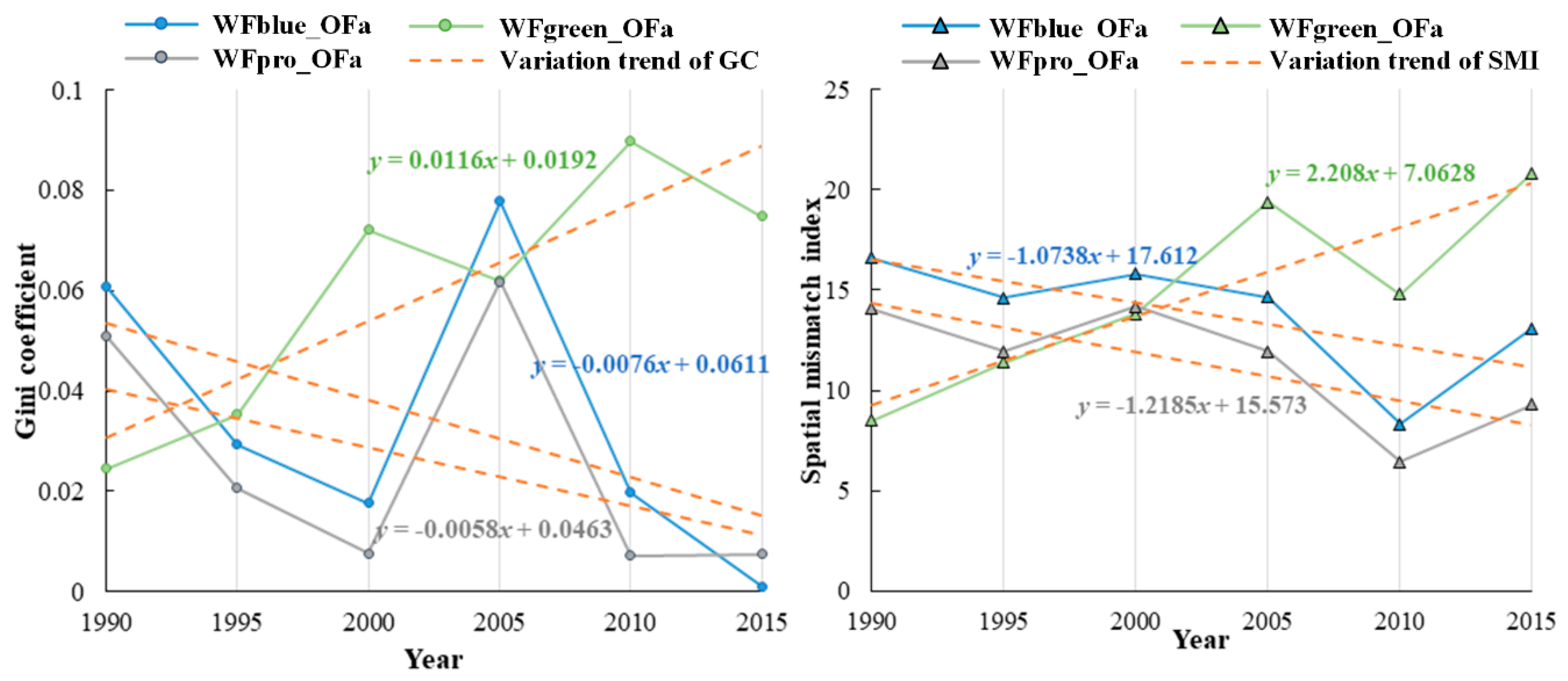
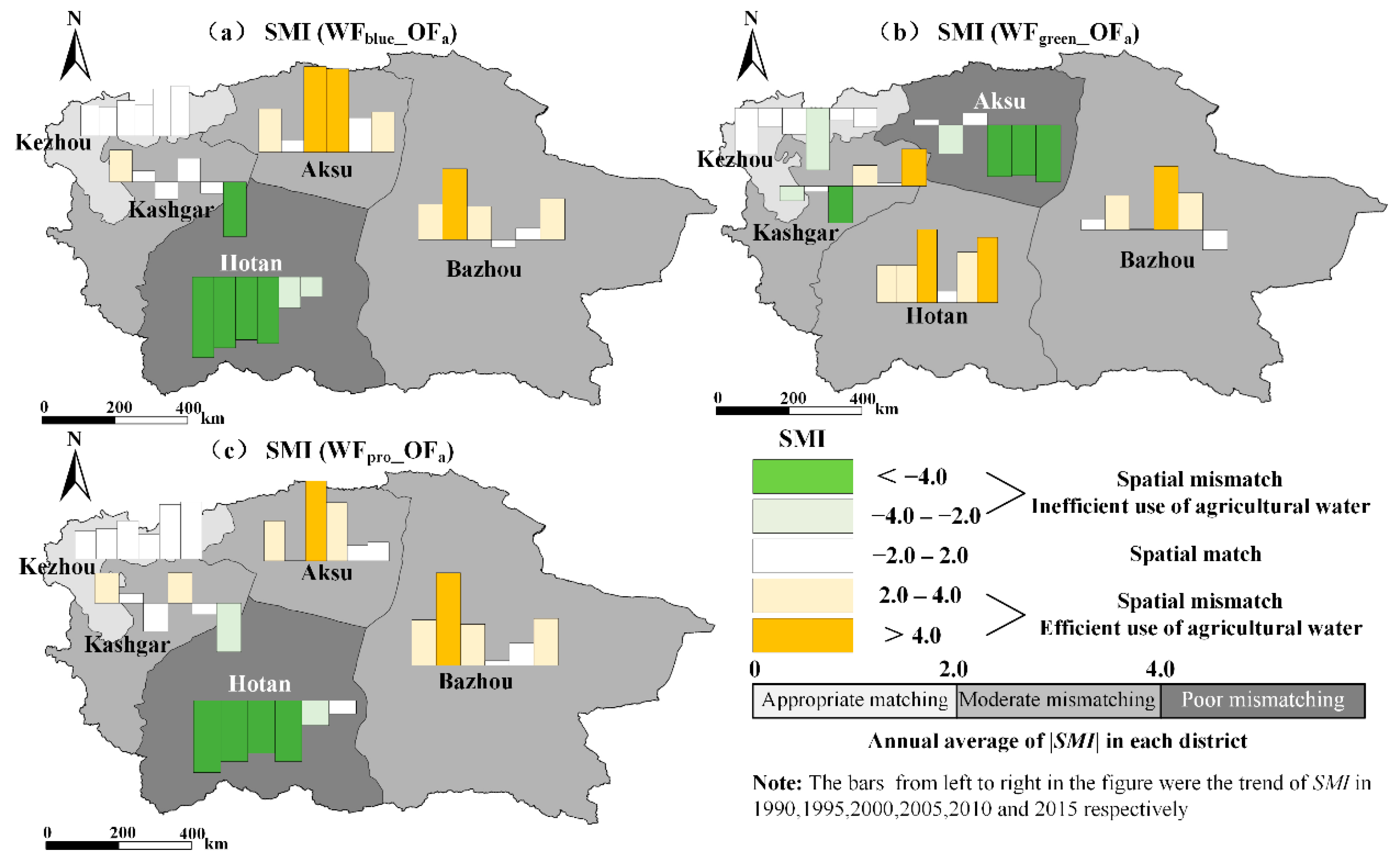
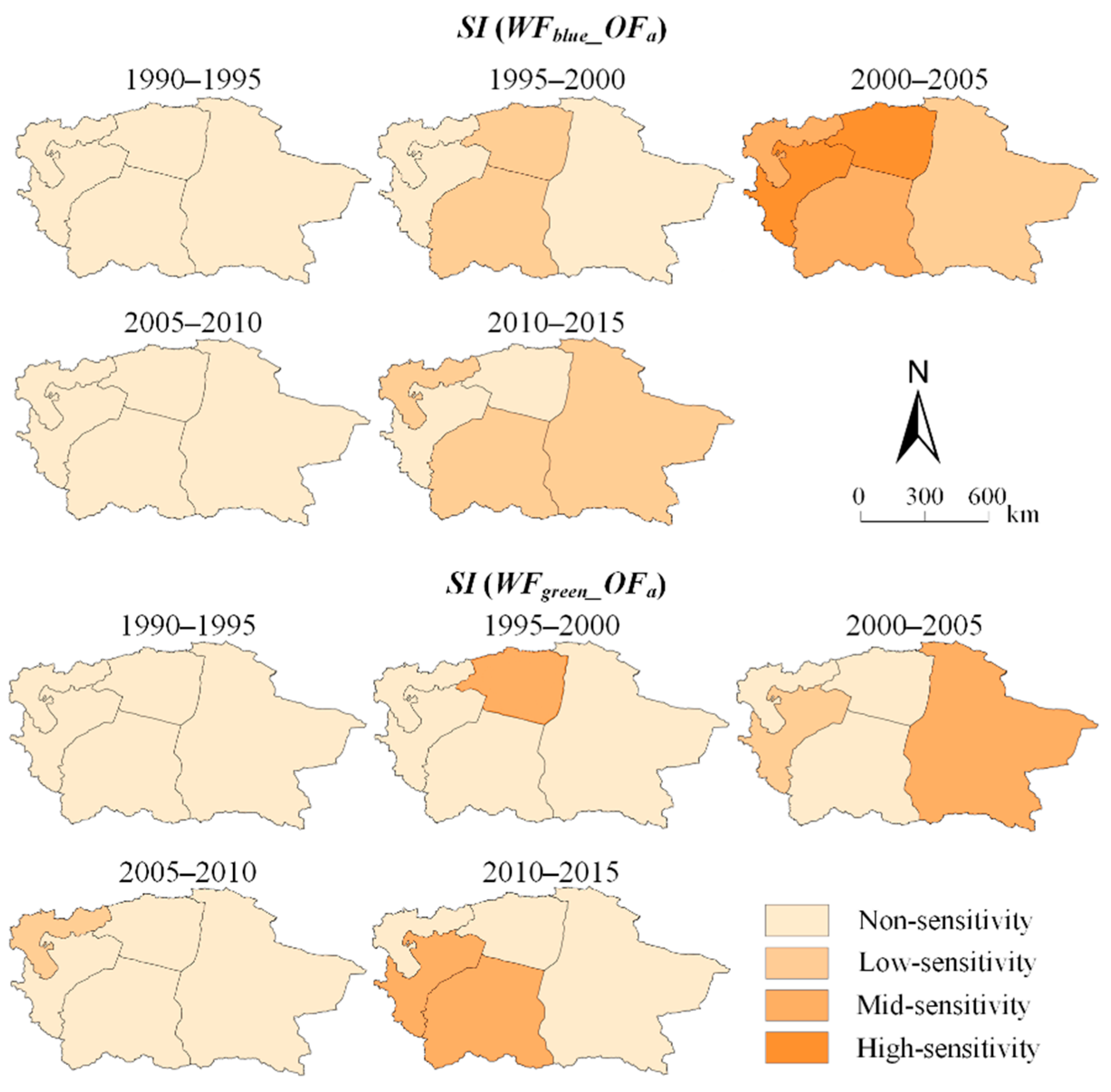
Publisher’s Note: MDPI stays neutral with regard to jurisdictional claims in published maps and institutional affiliations. |
© 2021 by the authors. Licensee MDPI, Basel, Switzerland. This article is an open access article distributed under the terms and conditions of the Creative Commons Attribution (CC BY) license (http://creativecommons.org/licenses/by/4.0/).
Share and Cite
Long, A.; Yu, J.; Deng, X.; He, X.; Gao, H.; Zhang, J.; Ren, C.; Du, J. Understanding the Spatial-Temporal Changes of Oasis Farmland in the Tarim River Basin from the Perspective of Agricultural Water Footprint. Water 2021, 13, 696. https://doi.org/10.3390/w13050696
Long A, Yu J, Deng X, He X, Gao H, Zhang J, Ren C, Du J. Understanding the Spatial-Temporal Changes of Oasis Farmland in the Tarim River Basin from the Perspective of Agricultural Water Footprint. Water. 2021; 13(5):696. https://doi.org/10.3390/w13050696
Chicago/Turabian StyleLong, Aihua, Jiawen Yu, Xiaoya Deng, Xinlin He, Haifeng Gao, Ji Zhang, Cai Ren, and Jie Du. 2021. "Understanding the Spatial-Temporal Changes of Oasis Farmland in the Tarim River Basin from the Perspective of Agricultural Water Footprint" Water 13, no. 5: 696. https://doi.org/10.3390/w13050696





